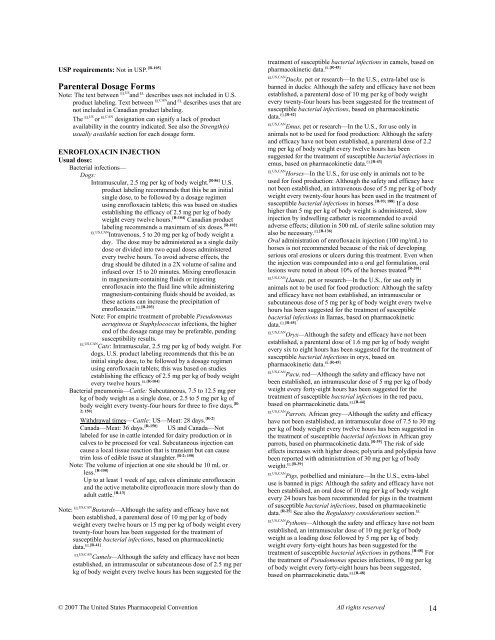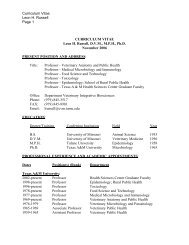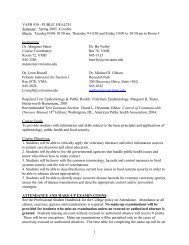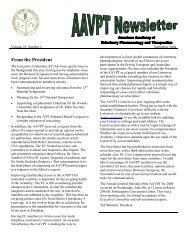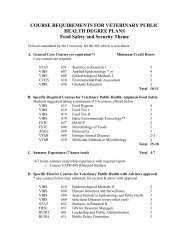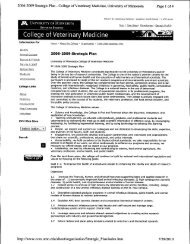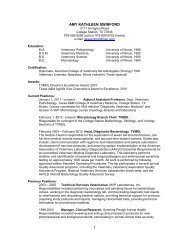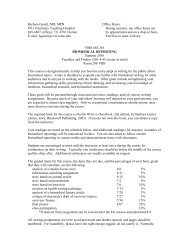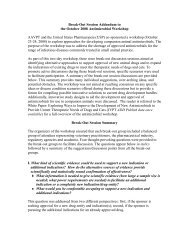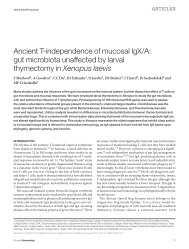FLUOROQUINOLONES (Veterinary—Systemic) - College of ...
FLUOROQUINOLONES (Veterinary—Systemic) - College of ...
FLUOROQUINOLONES (Veterinary—Systemic) - College of ...
You also want an ePaper? Increase the reach of your titles
YUMPU automatically turns print PDFs into web optimized ePapers that Google loves.
USP requirements: Not in USP. {R-105}<br />
Parenteral Dosage Forms<br />
Note: The text between ELUS and EL describes uses not included in U.S.<br />
product labeling. Text between ELCAN and EL describes uses that are<br />
not included in Canadian product labeling.<br />
The ELUS or ELCAN designation can signify a lack <strong>of</strong> product<br />
availability in the country indicated. See also the Strength(s)<br />
usually available section for each dosage form.<br />
ENROFLOXACIN INJECTION<br />
Usual dose:<br />
Bacterial infections—<br />
Dogs:<br />
Intramuscular, 2.5 mg per kg <strong>of</strong> body weight. {R-86} U.S.<br />
product labeling recommends that this be an initial<br />
single dose, to be followed by a dosage regimen<br />
using enr<strong>of</strong>loxacin tablets; this was based on studies<br />
establishing the efficacy <strong>of</strong> 2.5 mg per kg <strong>of</strong> body<br />
weight every twelve hours. {R-104} Canadian product<br />
labeling recommends a maximum <strong>of</strong> six doses. {R-102}<br />
ELUS,CAN<br />
Intravenous, 5 to 20 mg per kg <strong>of</strong> body weight a<br />
day. The dose may be administered as a single daily<br />
dose or divided into two equal doses administered<br />
every twelve hours. To avoid adverse effects, the<br />
drug should be diluted in a 2X volume <strong>of</strong> saline and<br />
infused over 15 to 20 minutes. Mixing enr<strong>of</strong>loxacin<br />
in magnesium-containing fluids or injecting<br />
enr<strong>of</strong>loxacin into the fluid line while administering<br />
magnesium-containing fluids should be avoided, as<br />
these actions can increase the precipitation <strong>of</strong><br />
enr<strong>of</strong>loxacin. EL{R-203}<br />
Note: For empiric treatment <strong>of</strong> probable Pseudomonas<br />
aeruginosa or Staphylococcus infections, the higher<br />
end <strong>of</strong> the dosage range may be preferable, pending<br />
susceptibility results.<br />
ELUS,CAN<br />
Cats: Intramuscular, 2.5 mg per kg <strong>of</strong> body weight. For<br />
dogs, U.S. product labeling recommends that this be an<br />
initial single dose, to be followed by a dosage regimen<br />
using enr<strong>of</strong>loxacin tablets; this was based on studies<br />
establishing the efficacy <strong>of</strong> 2.5 mg per kg <strong>of</strong> body weight<br />
every twelve hours. EL{R-104}<br />
Bacterial pneumonia—Cattle: Subcutaneous, 7.5 to 12.5 mg per<br />
kg <strong>of</strong> body weight as a single dose, or 2.5 to 5 mg per kg <strong>of</strong><br />
body weight every twenty-four hours for three to five days. {R-<br />
2; 150}<br />
Withdrawal times—Cattle: US—Meat: 28 days. {R-2}<br />
Canada—Meat: 36 days. {R-150} US and Canada—Not<br />
labeled for use in cattle intended for dairy production or in<br />
calves to be processed for veal. Subcutaneous injection can<br />
cause a local tissue reaction that is transient but can cause<br />
trim loss <strong>of</strong> edible tissue at slaughter.<br />
{R-2; 150}<br />
Note: The volume <strong>of</strong> injection at one site should be 10 mL or<br />
less. {R-150}<br />
Up to at least 1 week <strong>of</strong> age, calves eliminate enr<strong>of</strong>loxacin<br />
and the active metabolite cipr<strong>of</strong>loxacin more slowly than do<br />
adult cattle. {R-13}<br />
Note: ELUS,CAN<br />
Bustards—Although the safety and efficacy have not<br />
been established, a parenteral dose <strong>of</strong> 10 mg per kg <strong>of</strong> body<br />
weight every twelve hours or 15 mg per kg <strong>of</strong> body weight every<br />
twenty-four hours has been suggested for the treatment <strong>of</strong><br />
susceptible bacterial infections, based on pharmacokinetic<br />
data. EL{R-41}<br />
ELUS,CAN<br />
Camels—Although the safety and efficacy have not been<br />
established, an intramuscular or subcutaneous dose <strong>of</strong> 2.5 mg per<br />
kg <strong>of</strong> body weight every twelve hours has been suggested for the<br />
treatment <strong>of</strong> susceptible bacterial infections in camels, based on<br />
pharmacokinetic data. EL{R-45}<br />
ELUS,CAN<br />
Ducks, pet or research—In the U.S., extra-label use is<br />
banned in ducks: Although the safety and efficacy have not been<br />
established, a parenteral dose <strong>of</strong> 10 mg per kg <strong>of</strong> body weight<br />
every twenty-four hours has been suggested for the treatment <strong>of</strong><br />
susceptible bacterial infections, based on pharmacokinetic<br />
data. EL{R-42}<br />
ELUS,CAN<br />
Emus, pet or research—In the U.S., for use only in<br />
animals not to be used for food production: Although the safety<br />
and efficacy have not been established, a parenteral dose <strong>of</strong> 2.2<br />
mg per kg <strong>of</strong> body weight every twelve hours has been<br />
suggested for the treatment <strong>of</strong> susceptible bacterial infections in<br />
emus, based on pharmacokinetic data. EL{R-43}<br />
ELUS,CAN<br />
Horses—In the U.S., for use only in animals not to be<br />
used for food production: Although the safety and efficacy have<br />
not been established, an intravenous dose <strong>of</strong> 5 mg per kg <strong>of</strong> body<br />
weight every twenty-four hours has been used in the treatment <strong>of</strong><br />
susceptible bacterial infections in horses. {R-93; 188} If a dose<br />
higher than 5 mg per kg <strong>of</strong> body weight is administered, slow<br />
injection by indwelling catheter is recommended to avoid<br />
adverse effects; dilution in 500 mL <strong>of</strong> sterile saline solution may<br />
also be necessary. EL{R-136}<br />
Oral administration <strong>of</strong> enr<strong>of</strong>loxacin injection (100 mg/mL) to<br />
horses is not recommended because <strong>of</strong> the risk <strong>of</strong> developing<br />
serious oral erosions or ulcers during this treatment. Even when<br />
the injection was compounded into a oral gel formulation, oral<br />
lesions were noted in about 10% <strong>of</strong> the horses treated. {R-201}<br />
ELUS,CAN<br />
Llamas, pet or research—In the U.S., for use only in<br />
animals not to be used for food production: Although the safety<br />
and efficacy have not been established, an intramuscular or<br />
subcutaneous dose <strong>of</strong> 5 mg per kg <strong>of</strong> body weight every twelve<br />
hours has been suggested for the treatment <strong>of</strong> susceptible<br />
bacterial infections in llamas, based on pharmacokinetic<br />
data. EL{R-45}<br />
ELUS,CAN<br />
Oryx—Although the safety and efficacy have not been<br />
established, a parenteral dose <strong>of</strong> 1.6 mg per kg <strong>of</strong> body weight<br />
every six to eight hours has been suggested for the treatment <strong>of</strong><br />
susceptible bacterial infections in oryx, based on<br />
pharmacokinetic data. EL{R-45}<br />
ELUS,CAN<br />
Pacu, red—Although the safety and efficacy have not<br />
been established, an intramuscular dose <strong>of</strong> 5 mg per kg <strong>of</strong> body<br />
weight every forty-eight hours has been suggested for the<br />
treatment <strong>of</strong> susceptible bacterial infections in the red pacu,<br />
based on pharmacokinetic data. EL{R-44}<br />
ELUS,CAN<br />
Parrots, African grey—Although the safety and efficacy<br />
have not been established, an intramuscular dose <strong>of</strong> 7.5 to 30 mg<br />
per kg <strong>of</strong> body weight every twelve hours has been suggested in<br />
the treatment <strong>of</strong> susceptible bacterial infections in African grey<br />
parrots, based on pharmacokinetic data. {R-39} The risk <strong>of</strong> side<br />
effects increases with higher doses; polyuria and polydipsia have<br />
been reported with administration <strong>of</strong> 30 mg per kg <strong>of</strong> body<br />
weight. EL{R-39}<br />
ELUS,CAN<br />
Pigs, potbellied and miniature—In the U.S., extra-label<br />
use is banned in pigs: Although the safety and efficacy have not<br />
been established, an oral dose <strong>of</strong> 10 mg per kg <strong>of</strong> body weight<br />
every 24 hours has been recommended for pigs in the treatment<br />
<strong>of</strong> susceptible bacterial infections, based on pharmacokinetic<br />
data. {R-25} See also the Regulatory considerations section. EL<br />
ELUS,CAN<br />
Pythons—Although the safety and efficacy have not been<br />
established, an intramuscular dose <strong>of</strong> 10 mg per kg <strong>of</strong> body<br />
weight as a loading dose followed by 5 mg per kg <strong>of</strong> body<br />
weight every forty-eight hours has been suggested for the<br />
treatment <strong>of</strong> susceptible bacterial infections in pythons. {R-48} For<br />
the treatment <strong>of</strong> Pseudomonas species infections, 10 mg per kg<br />
<strong>of</strong> body weight every forty-eight hours has been suggested,<br />
based on pharmacokinetic data. EL{R-48}<br />
© 2007 The United States Pharmacopeial Convention All rights reserved 14


